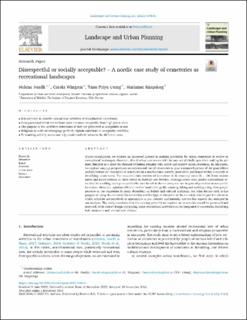| dc.contributor.author | Nordh, Helena | |
| dc.contributor.author | Wingren, Carola | |
| dc.contributor.author | Priya Uteng, Tanu | |
| dc.contributor.author | Knapskog, Marianne | |
| dc.coverage.spatial | Oslo, Norway | en_US |
| dc.date.accessioned | 2023-06-13T12:07:17Z | |
| dc.date.available | 2023-06-13T12:07:17Z | |
| dc.date.created | 2022-12-19T13:26:26Z | |
| dc.date.issued | 2022-12-05 | |
| dc.identifier.citation | Landscape and Urban Planning. 2022, 231 (March 2023), 1-9. | en_US |
| dc.identifier.issn | 0169-2046 | |
| dc.identifier.uri | https://hdl.handle.net/11250/3071152 | |
| dc.description | Published by Elsevier B.V. This is an open access article under the CC BY license (http://creativecommons.org/licenses/by/4.0/). | en_US |
| dc.description.abstract | Across Scandinavia, we witness an increased interest in making provisions for urban cemeteries to evolve as recreational landscapes. However, this development comes with its own set of challenges when uniting its primary function as a place for disposal of human remains with active and passive urban recreation. In this paper, we explore varying perspectives on recreational use of cemeteries to give a nuanced picture of the possibilities and limitations for recreation at cemeteries in a multicultural society, most often positioned within a context of densifying urban areas. The empirical data consists of interviews with cemetery users (N = 24) from various faiths and belief systems in three towns in Norway and Sweden. Findings reveal that passive recreational activities like strolling, having a cup of coffee on a bench in the cemetery etc. are in general perceived as acceptable behaviour. However, opinions differ on ‘active’ undertakings like running, biking and walking a dog. How people perceive or use cemeteries is partly dependent on beliefs and cultural traditions, but other factors such as the purpose of using the cemetery for recreation and the type or character of the cemetery also impact the extent to which activities are perceived as appropriate or not. Respect and intensity are two key aspects that emerged in our analysis. The study concludes that the existing peaceful atmosphere at cemeteries should be preserved and nurtured. With correct design and zoning, some recreational activities can be integrated at cemeteries, benefiting both mourners and recreational visitors. | en_US |
| dc.description.abstract | Disrespectful or socially acceptable? – A nordic case study of cemeteries as recreational landscapes | en_US |
| dc.language.iso | eng | en_US |
| dc.publisher | Elsevier | en_US |
| dc.title | Disrespectful or socially acceptable? – A nordic case study of cemeteries as recreational landscapes | en_US |
| dc.title.alternative | Disrespectful or socially acceptable? – A nordic case study of cemeteries as recreational landscapes | en_US |
| dc.type | Journal article | en_US |
| dc.type | Peer reviewed | en_US |
| dc.rights.holder | © 2022 The Authors. Published by Elsevier Ltd. | en_US |
| dc.source.articlenumber | 104645 | en_US |
| dc.description.version | publishedVersion | en_US |
| cristin.ispublished | true | |
| cristin.fulltext | original | |
| cristin.qualitycode | 2 | |
| dc.identifier.doi | 10.1016/j.landurbplan.2022.104645 | |
| dc.identifier.cristin | 2095227 | |
| dc.source.journal | Landscape and Urban Planning | en_US |
| dc.source.volume | 231 | en_US |
| dc.source.issue | March 2023 | en_US |
| dc.source.pagenumber | 1-9 | en_US |
